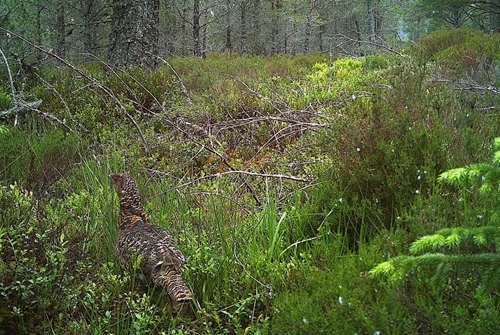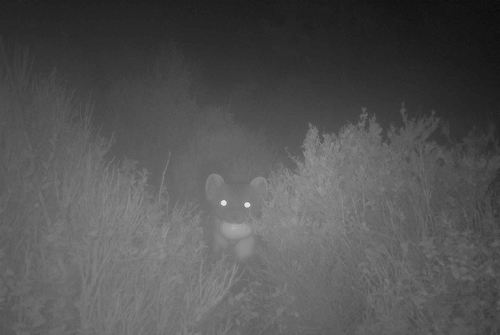A recently published study into the breeding and dispersal of capercaillie in Strathspey undertaken over four years from 2016-2019 has concluded that, without further managed landscape-scale intervention to improve breeding success, it is likely that the already threatened species will continue to decline.

Female capercaillie returning to nest captured on trail camera.
The study, Observations on breeding and dispersal by capercaillie in Strathspey, was undertaken by scientists from the Game & Wildlife Conservation Trust (GWCT), and co-funded by Scottish Natural Heritage (SNH), Scottish Forestry (formerly Forestry Commission Scotland), Forestry and Land Scotland (formerly Forest Enterprise Scotland) and the Cairngorms National Park Authority.
The Scottish capercaillie has been declining in range and numbers since the 1970s, and now there may be fewer than 1,000 birds remaining, chiefly in Strathspey.
This latest study, involving the radio-tagging of six females, allowed 12 possible breeding attempts to be followed. Nine clutches were laid of which six then hatched, with three probably predated by pine martens. Of the six broods, only two fledged chicks, a chick survival rate of just 8%. The low chick survival could be due to predation, poor post-hatch weather or impacts of sheep tick, but these all require further study.
 Pine marten close to nest carrying a capercaillie egg, captured on trail camera.
Pine marten close to nest carrying a capercaillie egg, captured on trail camera.
Dispersal distances of the tagged birds ranged from 3.5km to 16.3km, highlighting the importance of conservation action across neighbouring forests and at landscape scale.
Dr Kathy Fletcher, Senior Research Assistant, Scottish Upland Research, GWCT, who with Dr Dave Baines, GWCT Director of Upland Research, co-authored the study, says: “This study highlights just how low capercaillie breeding success is now in the heart of its range. If we wish to have any chance of stabilising numbers, it will require further studies that focus on why chick survival is so low, with subsequent management interventions at landscape scales.”
The full study is now available in Scottish Birds or downloadable here.
Notes to editors
The Game & Wildlife Conservation Trust is an independent wildlife conservation charity which carries out scientific research into Britain’s game and wildlife. We advise farmers and landowners on improving wildlife habitats. We employ 22 post-doctoral scientists and 50 other research staff with expertise in areas such as birds, insects, mammals, farming, fish and statistics. We undertake our own research as well as projects funded by contract and grant-aid from Government and private bodies. The Trust is also responsible for a number of Government Biodiversity Action Plan species and is lead partner for grey partridge and joint lead partner for brown hare and black grouse.
For information, contact:
Playfair Walker
Telephone: 0131 445 5570
Email: richard@playfairwalker.com